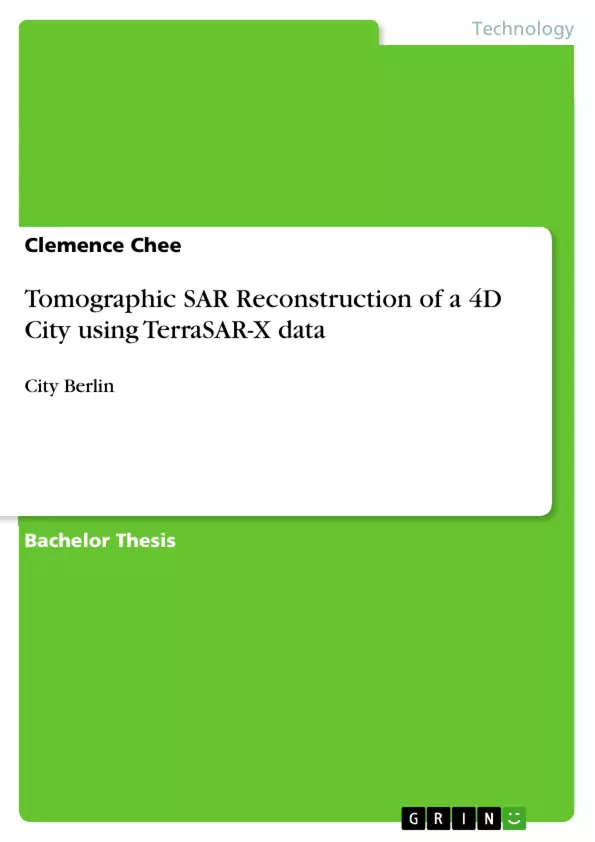Driven by military and civilian applications, the demand of very high resolution mapping
and accurate monitoring has increased rapidly over the recent years. Nowadays, it is
possible to create 4D models involving time variations using multiple synthetic aperture
radar (SAR) images, combined with interferometric methods. SAR has evolved to satisfy
a variety of applications for civilian and military users, for example by supporting
catastrophe management, detection of geological changes, monitoring large construction
sites or mines. With the help of SAR data obtained from the TerraSAR-X satellite, infrastructural
monitoring is made possible from a distance. The benefit of this is that
potential collapse within mines or tunnels could be prevented. Concrete degradation that
could lead to building collapse, endangering people’s lives can also be identified before
any catastrophe has the chance to occur.
Currently, Tomographic SAR (TomoSAR) is the most advanced and competent interferometric
SAR (InSAR) method in the area of urban monitoring. TomoSAR makes
monitoring in 4D possible by creating the 3D position with the motion parameters.
This thesis applies a new TomoSAR technique and method, developed by ZHU and her
colleagues, 2012 [1], on a very high resolution (VHR) spotlight data stack in the area of
Berlin. The images were taken by the TerraSAR-X satellite (Germany) over a timeframe
of 3 years. The result is a 3D point cloud of the observed area, with the velocity of linear
motion and the amplitude of periodic motion.
The result of the work that forms the basis for this thesis, is the realization of high
deformation and motion in Berlin’s infrastructure, especially around Berlin’s main station,
on bridges (” Überflieger Brücke”) and railways - often up to 10mm.
Inhaltsverzeichnis (Table of Contents)
- Introduction
- Motivation: The 4th Dimension
- Purpose and Structure
- About TerraSAR-X
- TerraSAR-X Scanning Modes
- Theoretical Basics - SAR Principles
- SAR Geometry
- SAR Phase
- SAR Properties
- Layover
- Chirp
- Speckle
- SAR Image Resolution
- InSAR Basics
- Interferometric Phase
- InSAR Athmospheric Influences
- InSAR Height Retrieval
- Persistent Scatterer Interferometry (PSI)
- SAR Tomography
- TomoSAR
- TomoSAR Processing Procedures
- Pre-Processing
- Processing
- TomoSAR System Model
- TomoSAR Algorithm
- Application on Berlin Data Stack
- Downsampling
- Quality Measurements
- Creating Pixel Pairs
- Integration
- Filter Residual Phase
- Upsamling and Estimation
- Results and Analysis
- Deformations and Movements
- Seasonal Movements
- Linear Movements
- Verification and Observation of the processed SAR Data Stack
- TomoSAR Result Observation
- Virtual Inspection of Observation
- Inspected Targets
- ”Uberflieger Br¨ ¨ ucke”
- ”Berlin Hauptbahnhof”
- Conclusion
Zielsetzung und Themenschwerpunkte (Objectives and Key Themes)
The main objective of this bachelor thesis is to analyze the ground movements of an urban area using SAR images and TomoSAR techniques. The goal is to monitor urban infrastructure movements to prevent potential collapses using satellite images, which allows for a larger surveillance area compared to conventional ground geodesy measurements. The area of interest is the area around the Berlin main station and the Berlin zoo.
- The application of SAR Tomography for 4D city modeling.
- The use of very high resolution (VHR) SAR data for urban infrastructure monitoring.
- The identification and analysis of ground movements and building deformations in urban areas.
- The comparison of TomoSAR results with existing 3D city models.
- The potential and limitations of TomoSAR for future geodetic observations.
Zusammenfassung der Kapitel (Chapter Summaries)
The first two chapters focus on the theoretical basics of SAR and TomoSAR. Chapter 2 covers the principles of SAR, including SAR geometry, phase, properties like layover, chirp and speckle, as well as the resolution of SAR images. It also introduces InSAR basics, including interferometric phase, atmospheric influences, and height retrieval. Finally, it delves into Persistent Scatterer Interferometry (PSI) and SAR Tomography.
Chapter 3 then explores TomoSAR in more detail, including the processing procedures, pre-processing techniques to eliminate atmospheric phase screen (APS), and the different algorithms used for tomographic reconstruction. It describes the system model and the two primary TomoSAR algorithms, Maximum Detection and SLIMMER.
Chapter 4 delves into the application of TomoSAR on a high resolution TerraSAR-X data stack of Berlin. It outlines the steps taken for data pre-processing, including downsampling, quality measurements, creating pixel pairs, integration, filtering the residual phase, and upsampling and estimation.
Finally, Chapter 5 presents the results and analysis of the TomoSAR processing. It discusses the detected ground movements and building deformations, including seasonal and linear movements, and verifies the results by comparing them to real-world data and existing 3D city models.
Schlüsselwörter (Keywords)
The thesis focuses on the application of SAR Tomography (TomoSAR) for monitoring urban infrastructure movements. Key topics include very high resolution (VHR) SAR data, TerraSAR-X satellite data, 4D city modeling, ground deformation, and atmospheric phase screen (APS) elimination. It also explores the comparison of TomoSAR results with real-world data and existing 3D city models.
- Quote paper
- Clemence Chee (Author), 2012, Tomographic SAR Reconstruction of a 4D City using TerraSAR-X data, Munich, GRIN Verlag, https://www.hausarbeiten.de/document/208933


